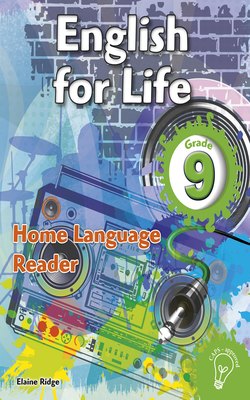Читать книгу English for Life Reader Grade 9 Home Language - Elaine Ridge - Страница 13
На сайте Литреса книга снята с продажи.
Оглавление| Pre-reading | |
| 1. | What do you know about District Six? Read the plaque in the illustration. The poem was written by the famous jazz musician Abdullah Ibrahim who grew up in District Six. |
| During reading | |
| 2. | The southeaster wind plays a strong role in Cape Town life. Notice the difference between the southeaster in the first stanza and in the second stanza. |
Blues for District Six
Dollar Brand (Abdullah Ibrahim)
early one new year’s morning
when the emerald bay waved its clear waters against the noisy dockyard
a restless southeaster skipped over slumbering lion’s head
danced up hanover street
tenored a bawdy banjo
strung an ancient cello
bridged a host of guitars
tambourined through a dingy alley
into a scented cobwebbed room
and crackled the sixth sensed district
into a blazing swamp fire of satin sound
early one new year’s morning
when the moaning bay mourned its murky waters against the deserted
dockyard
a bloodthirsty southeaster roared over hungry lion’s head
and ghosted its way up hanover street
empty
forlorn
and cobwebbed with gloom
where loneliness’ still waters meet nostalgia
and morning breaks the city sun and smoke
and towering grey the buildings’ murmur
grim subway rumbling in their roots
i scan the vacant faces and sad smiles
and long for home
banjos, cellos, guitars and tambourines – all types of musical instruments
tenored – made it sing (in a tenor voice)
ghosted – moved like a ghost
murky – muddy, not transparent
| Post-reading | ||
| 3. a) | What do you think has happened between the two stanzas? | |
| b) | Compare the form (the shape) of the two stanzas. In what way(s) are they similar? In what way(s) are they different? How do the differences contribute to the meaning? | |
| c) | In the first stanza the wind is said to “skip over” and “dance” but in the second it roars and is described as “bloodthirsty”. What does this suggest about the changes in its power, the sound it makes and what it makes people feel at different times and in different circumstances? | |
| 4. a) | What mood is established by the one-word lines? | |
| b) | Find five (or more) other words in the stanza that add to that mood. | |
| c) | In the box below, there is a powerful description of happy times in District Six, long ago before the removal of the people who lived there. The writer has chosen adjectives such as “emerald” to describe the waters of the bay. In the second stanza those describing words have been changed to show how the atmosphere has changed. Copy out the table below and fill in the blanks, using words from the second stanza. Part of the first one has been done for you. | |
| Stanza one | Stanza two | |
| “The emerald bay waved its clear waters” | “The moaning bay mourned its …..waters” | |
| “The restless southeaster” becomes a | “. . . . . . . southeaster” | |
| “The noisy dockyard” becomes a | “. . . . . . . . . dockyard” | |
| “The southeaster skipped” becomes | “The southeaster . . . . . .” | |
| “Slumbering lion’s head” becomes | “ . . . . . . . . lion’s head” | |
| “Crackled” becomes | “. . . . . . . .” | |
| 5. | We all have five senses: smell, taste, touch, hearing and sight. People speak of a sixth sense as intuition or sometimes as a rich connectedness to the hidden past or even to a spirit world. What things does “sixth sensed district” suggest about life in District Six? | |
| 6. | In the third line of the first stanza the poet uses alliteration (in this case, repeating the “s” sound) to add to the sense of a quiet and happy scene and to suggest the sound of the wind. What sense of the scene does the alliteration (repetition of the “m” sound) in the second line of the second stanza contribute to? | |
| 7. | The speaker does not once directly protest against the forced removal of people from District Six, yet this is a powerful protest poem that emphasises the heartbreak and destruction that was caused. Which image or part of the poem did you find most moving? Talk or write about it. |
